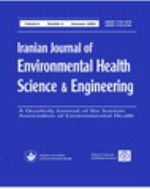
|
Iranian Journal of Environmental Health, Science and Engineering
Iranian Association of Environmental Health (IAEH)
ISSN: 1735-1979
Vol. 3, No. 3, 2006, pp. 147-160
|
 Bioline Code: se06022
Bioline Code: se06022
Full paper language: English
Document type: Research Article
Document available free of charge
|
|
|
Iranian Journal of Environmental Health, Science and Engineering, Vol. 3, No. 3, 2006, pp. 147-160
| en |
SYSTEM DYNAMICS-BASED CONFLICT RESOLUTION MODEL FOR RIVER WATER QUALITY MANAGEMENT
Karamouz, M.; Akhbari, M.; Moridi, A. & Kerachian, R.
Abstract
System dynamics approach by simulating a bargaining process can be used for resolving conflict of interests in water quality management. This approach can be a powerful alternative for traditional approaches for conflict resolution, which often rely on classical game theory. Waste load allocation models for river water quality management determine the optimal monthly waste load allocation to each point load. Most of these approaches are based on the multi-objective optimization models and do not consider the existing conflicts. In this study, a system dynamics-based conflict resolution model is presented for monthly waste load allocation in river systems. In this model, the stakeholders and decision-makers negotiate with each other considering their relative authorities, aspirations and dissatisfactions. System dynamics approach is actually used for simulating the bargaining process among the players. The model incorporates the objectives and preferences of stakeholders and decision-makers of the system in the form of utility functions and could provide a final agreement among the players. To evaluate the spatial and temporal variation of the concentration of the water quality indicator in the system, a water quality simulation model is also linked to the conflict resolution model. In the proposed model, a pre-assigned utility is allocated to different water users and the results are evaluated using a simulation model. The allocated utilities are tested and adjusted in order to provide an agreement between the assumed utilities and the utilities assigned by the model. The proposed model is applied to the Karkheh River system located in the southwest of Iran. The results show that the model can effectively incorporate the preferences of the players in providing a final agreement and the runtime of the proposed model is much less than the classical conflict resolution models. It is also shown that the waste load allocation can significantly reduce number and duration of the periods in which the river water quality violates the standards.
Keywords
River water quality management, system dynamics, simulation model, waste load allocation
|
| |
© Copyright 2006 - Tehran University of Medical Sciences Publications
Alternative site location: http://diglib.tums.ac.ir/pub/
|
|
